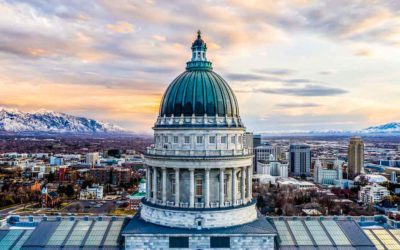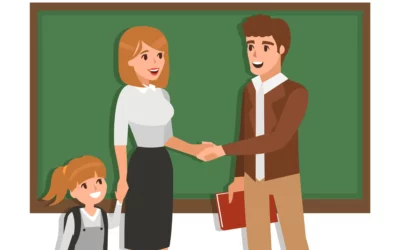
Written by Christine Cooke Fairbanks
November 17, 2022
In spring 2020, during the COVID-19 pandemic school shutdowns, the children of Kurt and Meagan Christensen struggled with the difficulties of remote learning in Alpine School District. Meagan, a former teacher, understood the challenges educators and schools faced. But as parents, they worried that key educational milestones would be missed, and they naturally wanted more for their children. So, in fall 2020 they decided to transfer their children to a local private school.
Private schools likely saw an uptick in enrollment during the pandemic because they offered a genuinely different option to families like the Christensens. Pandemic-driven enrollment growth may (or may not) have impacts on the trajectory of private schools going forward – time will tell.
What are private schools?
Private schools are schools operated by private organizations or individuals rather than the government and are funded in large part by fees known as tuition. Private schools can be either explicitly religious or secular in nature.
Families choose private schools for a variety of reasons. Many parents seek them out because they are looking for an education that is more academically rigorous, character based, religiously focused, physically safe, or socially prestigious.
A quick history
Before public schools of today or even the “common school” of the 1830s, most education was private. During the colonial days, the first private Catholic school was established in 1606 in St. Augustine, Fla., and over time the number of Catholic private schools grew. During this era, education was quite varied, and some would pool resources to privately pay for a teacher to instruct themselves or their children in formal schooling.
Early private schools were often founded with purposes that still linger in reputation today. Some were established to maintain an elite approach to education patterned after some schools in England. Others – like Roman Catholic private schools – were created as a response to Protestant teaching in schools.
Over time a system of public schools was established across the United States that eventually became the default choice for families, although private schools still operated. A challenge to an Oregon law compelling students to go to a public school resulted in the 1925 U.S. Supreme Court case Pierce v. Society of Sisters. The court held that parents had the right to direct the upbringing and education of their children and that the government couldn’t interfere with their right to send them to a private school – basically finding unconstitutional a law that compelled families to enroll children in a public school. Along with protecting parental rights in education, this ruling has protected private schooling in the United States ever since.
A look at the nation
As of fall 2019, 4.7 million K-12 grade students were enrolled in private schools, out of 53.9 million students either enrolled in public or private schools. This means roughly 9% of all public or private school students are in private schools.
For well over a decade, little has changed. The percentage of students attending private schools (approximately 9%) has basically stayed the same since 2009.
In the decades prior to that, private schools generally experienced an enrollment decline. In fact, even after advocacy for private school access – in the form of vouchers – from U.S. Secretary of Education Betsy DeVos, private school enrollment did not grow much nationally before the COVID-19 pandemic, and immediately prior to it had even begun to take a bit of a dip.
Declining enrollment has also been the reality for Catholic private schools, which once dominated the private school field. Catholic school enrollment dropped from 5.2 million in 1960 to 2 million in 2009 to 1.7 million in 2019, while enrollment in nonsectarian private schools increased between those years from 0.9 million to 1.1 million.
As with many areas of life, the COVID-19 pandemic changed a lot in education, including private school enrollment. While national data on private school is limited, one recent national survey showed the impact of the pandemic on private schools, revealing a general trend of increasing enrollment. Private schools were more likely to open their schools for in-person instruction than other schools, and many families chose to transfer possibly for this reason.
A look at Utah
Utah has more than 160 private schools, some of which are Catholic or other religious schools, and others are nonsectarian. While sources on private school enrollment are less accessible than public school data, the former is estimated at 21,101 for the 2022-23 academic year, which is 3% of all K-12 students in the state.
Like the national trend, the pandemic seems to have increased the number of Utah families choosing private options; the number of students who transferred to private schools after the COVID-19 pandemic grew by 25%.
Private schools are governed by some regulations in the state but are not under the supervision of the Utah State Board of Education. A limited number of policies require coordination between the public school system and private schools, including the Carson Smith Scholarship for students with special needs, which allows public school students with special needs to use tax dollars to attend a private school. Likewise, state education policy says that private school students can participate in public school extracurricular activities that are not offered at their private school. Still, in large part, private schools are separate from the public system.
Both public and private schools offer unique elements to students – like free access or academic rigor or wider extracurricular offerings or a religious focus – which is why they are both important to a truly pluralistic education environment in a state. States should do what they can to keep from regulating private schools out of their uniqueness – so private schools can continue offering important options to parents.
More Insights
Read More
Is California’s minimum wage hike a mistake?
Is raising the minimum wage a good tool to help low-income workers achieve upward mobility? That’s the key question at the heart of the debate over California’s new $20 an hour minimum wage law for fast food workers.
Why is Utah at odds with Justice Department over treatment of gender-dysphoric prisoner?
Lawsuit illustrates a little-known practice of federal agencies – giving various forms of “guidance” which are not supposed to be legally binding. The practice raises serious legal and constitutional questions.
What would a parent-teacher ‘handshake’ look like in Utah?
This partnership does not allow either party to pass blame entirely to the other. There is no scapegoat, only opportunities for either party or both to work on the factors within their scope.


